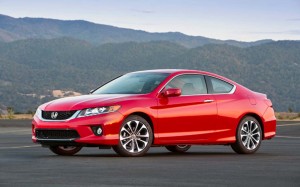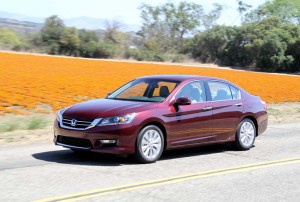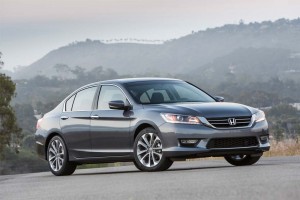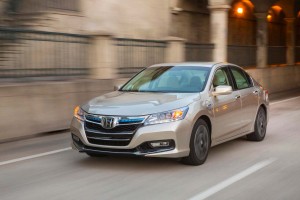Be prepared for one of the nastiest gunfights the auto industry has seen in years. The 2013 model-year will bring the launch of an assortment of new entries into the always-competitive midsize sedan segment, including an all-new Ford Fusion, Chevrolet Malibu and Nissan Altima. And now comes the new 2013 Honda Accord.
Once the dominant player in the midsize market, Honda has had to settle for second, for much of the last decade, chasing the Toyota Camry. But with all the new sheet metal, leadership is up for grabs. Nissan has openly declared its desire to topple the midsize king-of-the-hill. And you can bet that’s Honda’s goal, as well.
“It’s playing out like an arms race,” Honda product planner Vicki Popponi said during a media preview of the new Accord. And Honda is going to need to deliver the big guns. The maker took a critical drubbing when it launched an all-new Accord, two years ago, and has had some serious sales setbacks with other recent models including the Insight, CrossTour and CR-Z. So, there’s little room for error with the 2013 Honda Accord.
Honda gave a hint of what was to come when it revealed the Accord Coupe Concept at the Detroit Auto Show last January. The sedan is, in fact, more attractive, a surprise considering coupes are normally the more sporty and sexy members of a maker’s line-up. Honda officials note that spent more than $65 million to install a new stamping press at the Ohio assembly plant that will produce the Accord sedan in order to punch out more three-dimensional body panels.
The ninth-generation Accord doesn’t go for the radical styling changes of the Fusion but it’s a nonetheless handsome car, with sculpted side panels and a lower beltline that results in a light and airy “greenhouse” – which translates into more glass and better visibility. The look is a bit generic, overall, and it remains to be seen if midsize buyers will prefer that approach to the more extreme styling of the new Ford and the older Hyundai Sonata.
What may surprise buyers is that in a market where every successive generation seems to grow bigger and heavier, the new Accord is both smaller and lighter, shedding 3.6-inches, nose-to-tail and anywhere from 24 to 60 pounds, depending upon the model. The good news is that despite its smaller footprint, Honda has found ways to carve out more space for passengers – along with a larger, 15.5 cubic-foot trunk.
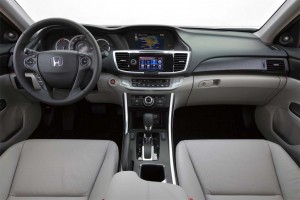
Though smaller on the outside the 2013 Honda Accord offers more interior passenger room and cargo space.
Give credit to an all-new platform that makes increased use of high-strength steel as well as lightweight aluminum. Honda is notably expecting the new Accord to not only top the list when it comes to traditional crash testing but also to deliver a good rating in the Insurance Institute for Highway Safety’s new frontal, offset-pole crash. Only a handful of models tested so far have passed this test.
Rear-seat passengers will be especially pleased with the new Accord design. By not opting for the coupe-like roofline that has become the latest styling trend, Honda has given those in the back seat plenty of headroom – and easy access.
Inside, it’s clear Honda wasn’t going to make the same mistake it did with the latest-generation Civic. The small car was rightly faulted for its use of cheap, hard plastic panels that made it clear the carmaker was cutting corners.
The 2013 Accord features a far more refined and well-tailored cabin that’s placed soft-touch materials in all the right places that driver and passenger will likely come in contact with. As with the exterior, Honda went to a more sculpted look, though it avoided the fancy layouts some competitors have been opting for. One of the more interesting elements of the design is the addition of twin LCD displays, the upper primarily used for navigation, the lower for audio and related technologies. There’s yet a third control panel for climate control.
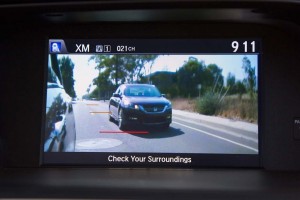
Honda's unique blind spot monitoring system uses cameras in the sideview mirror to display an image of what's out of sight.
A curious move was the decision to excise the tuning knob, forcing a driver to have to change stations by tapping the touchscreen display. That’s an approach several other makers have also taken and we’ve yet to find any that have improved over the old knobs. Please Honda, bring it back as soon as possible.
One other disappointment was wind noise. Honda officials insisted they’d done a lot to quiet down the cabin of the new sedan. But it simply isn’t as quiet as promised and the lack of laminated side windows is part of the problem. We’re hoping Honda will make the upgrade when it’s time for a mid-cycle refreshing of the new line.
As one might expect, Honda has added a number of high-tech features, including some intriguing new safety technology. That includes a unique take on the concept of blind-spot monitoring. Rather than using sensors to sound an alert when another car is in the blind spot the optional new Accord system displays a real-life image on the navigation screen taken by the cameras hidden inside each of the car’s sideview mirrors. It’s a distinctly different approach and it means glancing to the center stack before changing lanes. Does it work? We’ll reserve judgment until we’ve clocked more time in the new Accord. But it could lead to a day when conventional sideview mirrors — which create a lot of wind noise and aero drag — are replaced by lipstick-sized cameras.
Honda has traditionally liked to bill itself as an engine company that also builds cars. There’s no question it set the industry trend in earlier years with technologies like the original CVCC engine and the later VTEC. In recent years, however, Honda has tended to lag behind, smugly sticking with its old engine designs while competitors have migrated to more advanced direct injection powerplants and added more advanced 6-, 7-, 8- and even 9-speed gearboxes.
With the launch of the new Accord, Honda introduces its new Eart Dreams powertrain technology which includes the maker’s first use of direct injection. The Accord also gets a new CVT, or continuously variable transmission. Using DI helps the base 4-cylinder make a reasonable 185 horsepower and 181 lb-ft of torque. Pairing that with a new CVT also helps bump fuel economy up to as much as 27 mpg city, 36 highway and a combined 30 mpg.
That’s only good enough for silver, the 2013 Nissan Altima beating it on the highway by one mpg, but it is still likely to impress potential buyers. And in terms of annual fuel costs the difference is minimal, at most.
The I-4 engine doesn’t offer a conventional automatic with the ninth-generation Accord but those who want a bit more sporty ride will likely go for the six-speed manual.
The CVT isn’t a bad choice, however. And unlike most competitive versions, including Altima, there’s virtually none of the classic “rubber banding” effect, where the engine revs to red line and then waits while the car catches up.
Unlike some competitors – notably including Chevrolet, Hyundai and Kia – Honda has chosen to maintain a V-6 option for the 2013 Accord and it’s likely to be the engine of choice for those who put pep over mileage. The engine makes a solid 278 horsepower and 252 lb-ft of torque without completely tossing fuel economy out the window. With the six-speed automatic you’ll still get 21 mpg City, 34 highway and 25 combined. There’s also a 6-speed stick that is as pleasant to operate as anything we can ever remember from Honda, delivering quick and precise gear changes.
In mid-model-year, Honda will launch a third powertrain package: a plug-in hybrid. It pairs a modest 2.0-liter inline-four gas engine with an electric motor to produce a combined 196 horsepower and 226 lb-ft of torque. The combination is peppier than that might sound thanks to the way electric motors deliver maximum torque the moment they start spinning.
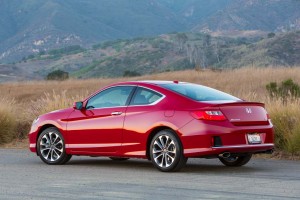
The Accord sedan goes on sale Sept. 19, the coupe to follow mid-October and the PHEV early next year.
According to the EPA, the new model gets a whopping 100 MPGe, or miles per gallon-equivalent. But we’re disappointed that Honda opted for a meager 6.7 kilowatt-hour lithium-ion battery that will deliver a mere 10 to 15 miles in battery mode – well less than half that of a Chevrolet Volt. The plus side is that the Accord PHEV’s cost will be significantly lower, as well. But the reality is that it will be difficult to justify even the more modest price bump based on the relatively little fuel most motorists will likely save. The big advantage will be getting the commuter-lane stickers offered by California and other states to plug-ins.
Honda will also add a fourth powertrain later, a conventional hybrid – the first in the Accord line.
One of the more significant shifts for 2013 is the new electric power-assist steering, or E-PAS, system Honda has opted for. It’s not alone. Even Porsche has had to go electric considering it’s a fast way to improve fuel economy by as much as 5 to 10%. The good news is that Honda engineers have been able to make the switch without suffering the degradation in driving feel we’ve experienced on a number of other new models in recent years.
The 2013 Honda Accord also opts for an all-new suspension layout, the traditional front double-wishbone being replaced by a MacPherson strut layout. That may disappoint some but in a day of driving we were impressed by the overall road manners of the new sedan. If anything, the new Accord felt like a classic Honda, light, nimble and responsive – both during a day of street driving and another several hours blasting around the Streets of Willow, a tight and twisty racetrack in Rosamond, California.
The new 2013 Honda Accord has a definite advantage over the 2012 Toyota Camry, which tended to wallow around the course requiring a lot of effort to keep it on line.
Our bottom line: the 2013 Honda Accord shows that the Japanese maker has clearly learned the lessons from recent mistakes, notably including the latest Civic. No, it’s not the sexiest new design in the midsize segment, nor is it the most fuel-efficient entry. But it’s more than attractive enough and it still delivers solid mileage while also offering what may be the most fun-to-drive package we’ve yet experienced in the segment.
Prices for the new Accord range from $21,680 to $23,430 – about $300 over prior-year models, on average, though the 2013s feature significant new levels of content, such as blind-spot monitoring. Look for the 2013 Honda Accord sedan to roll into showrooms on September 19. The Accord Coupe will follow about a month later. And the Accord PHEV will go on sale sometime early in 2013.

